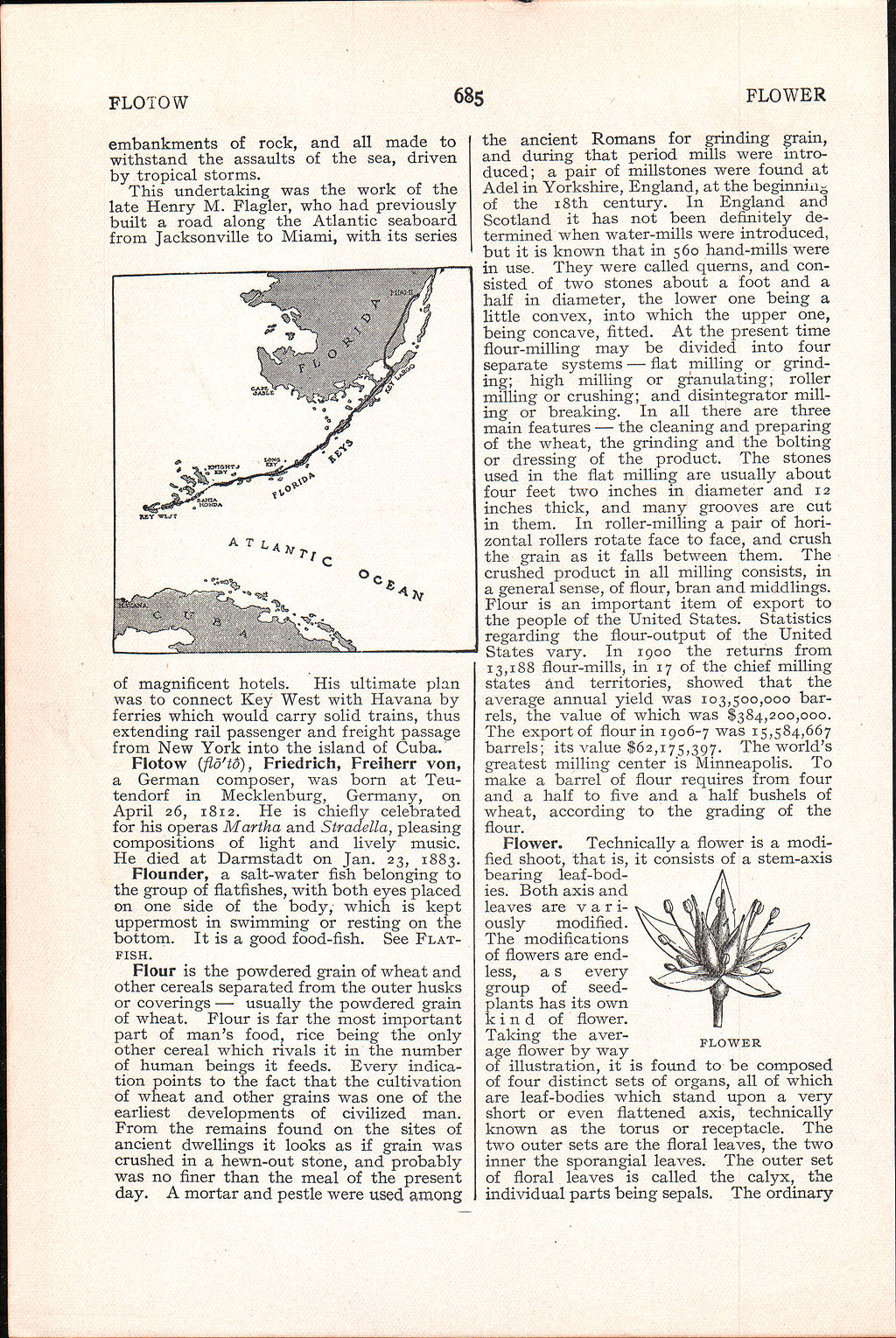embankments of rock, and all made to withstand the assaults of the sea, driven by tropical storms.
This undertaking was the work of the late Henry M. Flagler, who had previously built a road along the Atlantic seaboard from Jacksonville to Miami, with its series of magnificent hotels. His ultimate plan was to connect Key West with Havana by ferries which would carry solid trains, thus extending rail passenger and freight passage from New York into the island of Cuba.
Flotow (flō′tṓ), Friedrich, Freiherr von, a German composer, was born at Teutendorf in Mecklenburg, Germany, on April 26, 1812. He is chiefly celebrated for his operas Martha and Stradella, pleasing compositions of light and lively music. He died at Darmstadt on Jan. 23, 1883.
Flounder, a salt-water fish belonging to the group of flatfishes, with both eyes placed on one side of the body, which is kept uppermost in swimming or resting on the bottom. It is a good food-fish. See Flatfish.
Flour is the powdered grain of wheat and other cereals separated from the outer husks or coverings — usually the powdered grain of wheat. Flour is far the most important part of man's food, rice being the only other cereal which rivals it in the number of human beings it feeds. Every indication points to the fact that the cultivation of wheat and other grains was one of the earliest developments of civilized man. From the remains found on the sites of ancient dwellings it looks as if grain was crushed in a hewn-out stone, and probably was no finer than the meal of the present day. A mortar and pestle were used among the ancient Romans for grinding grain, and during that period mills were introduced; a pair of millstones were found at Adel in Yorkshire, England, at the beginning of the 18th century. In England and Scotland it has not been definitely determined when water-mills were introduced, but it is known that in 560 hand-mills were in use. They were called querns, and consisted of two stones about a foot and a half in diameter, the lower one being a little convex, into which the upper one, being concave, fitted. At the present time flour-milling may be divided into four separate systems — flat milling or grinding; high milling or granulating; roller milling or crushing; and disintegrator milling or breaking. In all there are three main features — the cleaning and preparing of the wheat, the grinding and the bolting or dressing of the product. The stones used in the flat milling are usually about four feet two inches in diameter and 12 inches thick, and many grooves are cut in them. In roller-milling a pair of horizontal rollers rotate face to face, and crush the grain as it falls between them. The crushed product in all milling consists, in a general sense, of flour, bran and middlings. Flour is an important item of export to the people of the United States. Statistics regarding the flour-output of the United States vary. In 1900 the returns from 13,188 flour-mills, in 17 of the chief milling states and territories, showed that the average annual yield was 103,500,000 barrels, the value of which was $384,200,000. The export of flour in 1906-7 was 15,584,667 barrels; its value $62,175,397. The world's greatest milling center is Minneapolis. To make a barrel of flour requires from four and a half to five and a half bushels of wheat, according to the grading of the flour.

|
| FLOWER |
Flower. Technically a flower is a modified shoot, that is, it consists of a stem-axis bearing leaf-bodies. Both axis and leaves are variously modified. The modifications of flowers are endless, as every group of seed-plants has its own kind of flower. Taking the average flower by way of illustration, it is found to be composed of four distinct sets of organs, all of which are leaf-bodies which stand upon a very short or even flattened axis, technically known as the torus or receptacle. The two outer sets are the floral leaves, the two inner the sporangial leaves. The outer set of floral leaves is called the calyx, the individual parts being sepals. The ordinary

